A
storybook beginning for old Reed School
By Mike Kuzjak
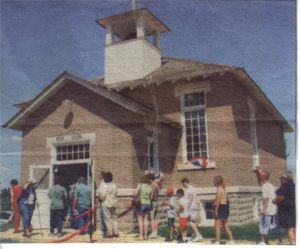
During Sunday’s
dedication, a total of 354 visitors lined up for a tour of the interior of the
Reed School, the 10th and newest historic site of the Wisconsin
Historical Society, located two miles east of Neillsville.
The grand re-opening of the old Reed School had the pomp and circumstance of Commencement Day.
A uniformed brass band playing John Phillip Sousa
compositions, esteemed dignitaries delivering lofty speeches and, to top it
all off, the bluest sky on the sunniest of recent Sundays seemed to bless the
dedication of the former one-room school house as the Wisconsin Historical,
Society’s 10th historic site in the state.
It couldn’t have happened without Gordon Smith.
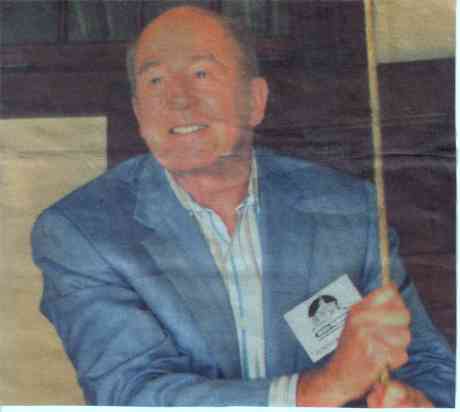
With his vision
for the future of Reed School preserved with the help of the Wisconsin
Historical Society, Gordon Smith pulls on the school bell rope to signal the
beginning of a new chapter in the school’s history and welcome other
“former students” back to tour the refurbished building.
The Washington DC-area businessman was there, proudly wearing his “Former Student” identification tag, like many others there. But unlike most of the others who completed the entire eight years of their grade school education at the century-old building that finally closed its doors in 1951, Smith was a student there for just six short weeks. During that span of time, back in 1939, he learned the life-long lessons for which he has surely remained eternally grateful.
Smith now 74, recently purchased the school and, in a partnership with the Wisconsin Historical Society, established a foundation and programming that will, for generations to come, have the school educating the public about the basic lessons of life that had served him so well.
That was cause for celebrations last Sunday as scores of visitors to Reed School east of Neillsville filled a nearby tent for the opening ceremony. Sitting on the raised dais with the other honored guests, Smith listened as an array of invited dignitaries spoke of the momentous occasion.
When his turn finally came to say a few words, Smith frankly told the audience that he had a story to tell and asked for their patience.
Then, in an easy, unpretentious manner, Smith began by recalling his privileged schooling in Gary, Ind., one that included swimming pools, auditoriums, gymnasiums, even a lagoon in which elegant swans could be seen swimming about. “And it had all the play equipment you can imagine,” he said.
Smith was in the first grade when his parents decided to go on an extended vacation and, in the meantime, send their six-year-old son to stay with trusted country relatives in Neillsville. There he was to attend Reed School which had neither the facilities, nor the finery, of his school in Gary.
“It was a nice change, for me,” Smith told the audience and proceeded to explain why Reed School offered so much more in its simple educational formula. As one of the youngest students, he was among the first to recite his lesson to the teacher, Norma Schmoll, he recalled. He would then listen as she continued on from the first-graders to test the second graders. He remembered often wondering, “Can I do that?” He had to challenge himself even more as the teacher proceeded to move on in the day’s lessons prepared by the students in the still higher grades.
“That was my learning experience,” Smith said.
But there was even more to his education while staying in Neillsville.
Outside the school, kids had to be creative, Smith said, even in their seemingly simple games such as hide-and-go-seek. In regaling his audience as he often did during his speech, Smith even told of once, while out in a farm pasture with a friend, making a contest out of who could stomp on the most cow pies, the fresher the better.
While staying on the farm, Smith recalled he pitched in to help with chores. He vividly remembered the threshing of grain, and the harvest crew in which he, as the “blower boy,” was proudly part of a much larger team effort. “That was hard work and very formative,” he said.
When his stay at Neillsville was over, the young Smith packed up those lessons in life, along with his other belongings, and took them back to Gary. He would keep them in mind, he said, as he went off to college, became a pilot in the US Air Force, entered Harvard Business School and then left there for a career path in the home-building business. During a prosperous 45-year history, his company rose in the ranks of the industry to become 87th in size among the more than 10,000 construction firms in the US.
Standing at the podium last Sunday, Smith wistfully recollected returning to visit his country cousins three years ago. He happened to stop by the old Reed School, he said. Walking around the empty school building, he began reminiscing. That turned to imagining, creatively, what he could do. Finally, the question arose: Why not turn the marvelous old school building into a learning and historical center so that kids, and adults, as well, could share in the educational experience he had nearly 70 years ago?
In refurbishing the building from top to bottom, Smith insisted on authenticity, right down to the construction in the school yard of an outhouse, dubbed the “Real McCoy,” in addition to the more modern restroom facility. The reason was simple, said Smith, a youthful twinkle in his eye. “If you were a fourth-grade boy, which one would you use?” he asked the audience whose collective laughter affirmed there was no doubt about that answer.
With that, the day’s program proceeded to a ribbon-cutting ceremony at the front of the school building, followed by Smith ringing the bell as the other “former students” led the procession of more than 350 visitors on a tour of the building.
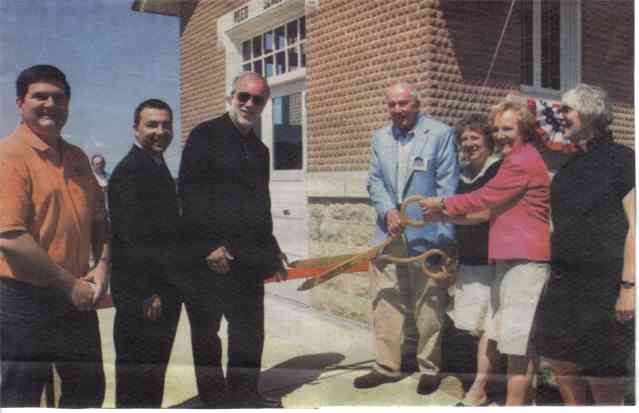
The official
ribbon-cutting ceremony at Reed School featured the honored guests of the day,
including Gordon Smith doing the honors, his daughter, Cindy Skarbek, director
of the family Foundation, and his wife, Helen.
The other guests (from left to right) are State Senator Pat Kreitlow,
Assemblyman Scott Suder, Ellsworth Brown, Wisconsin Historical Society
director, and (at far right) Helen Laird, a member of the Historical
Society’s Board of Curators.
Meanwhile, out in the school yard, the band played
on. A souvenir table laden with
rulers, pencils, and other memorabilia, compliments of the Historical Society,
was a busy place as was an ice cream stand.
Kids enjoyed playing in the playground area that included a replica of
an old-time hand swing.
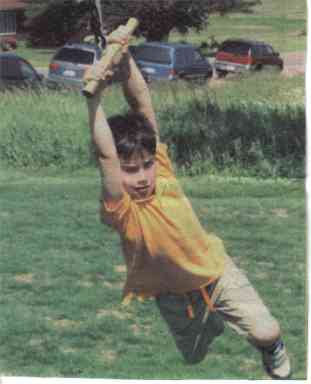
Seven-year-old
Jack Knowlton, of Eau Claire, whose mom is a UW history professor, gets his
hands on a swing set, part of the extensive renovation project to recreate the
life, and times, of rural one-room school houses during the first half of the
last century.
“It’s a great day,” Smith later said, acknowledging that, with the management of the Wisconsin Historical Society, there are sure to be many more wonderful days for the school and those that would come to experience it in its renewed role.
And yes, Smith added with a smile, he will be back
in the coming years to visit the school, and the community, that he had never
really left behind.
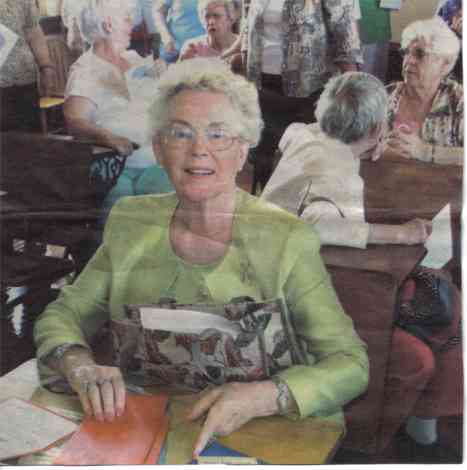
After 60 years,
Sharon Moberg Horswill, of Tomahawk, Wis., happily returns to the very same
seat she sat in during her 6th grade at Reed School in 1947.
¤¤¤¤¤¤¤¤¤¤¤
The
Reed School, located two miles east of Neillsville at the intersection of
Cardinal Avenue and US Hwy 10, will be open to the public Saturday and Sunday,
June 16th through Sept. 30th from 10 a.m. to 4 p.m.
There is no charge for admission.
¤¤¤¤¤¤¤¤¤¤¤¤
From the
front page of the Clark County Press, Neillsville, WI
June 13, 2007.
Transcribed by Dolores Mohr Kenyon, June 19, 2007.
Web page by James W. Sternitzky PhD, June 29, 2007.
Return to Grant Township Schools Web Page
Return to
Grant Township Home Page
**This Clark
Co., WI Internet Library, ALHN & AHGP website is dedicated to the free
sharing of information by researchers, local historians, genealogists and
educators. Because of our non-profit status, submissions are not to be
used for profiteering of any kind. Our representatives cannot
accept gratuities beyond the basic expenses (i.e. postage, copying, courthouse
or rental fees) for obtaining requested information. We reserve the
right to ban the involvement of anyone who intentionally disregards these
policies. Promotion of research services or publications is not
permitted on these pages, or by our representatives without the prior
endorsement of the site overseers. If you need professional help, we
recommend contacting an accredited genealogist. Please show your
appreciation for this database by Becoming
a Clark County History Buff or making a contribution to our Support
Fund and Perpetual Preservation Account to help keep this Clark
Co., WI database freely available on the World Wide Web and free from
commercial enterprise. *** This
copyrighted Clark Co., Wis. genealogy and history material is used on this
nonprofit site with permission of the submitter. Contact us if you are
personally aware of anyone using this submitted data inappropriately. It
may not be copied and posted on any commercial genealogy sites such as Family
Tree Maker or the merged companies Ancestry.Com/RootsWeb/MyFamily or sold for
personal profit.
|
© Every submission is protected by the Digital Millennium Copyright Act of 1998.
Show your appreciation of this freely provided information by not copying it to any other site without our permission.
Become a Clark County History Buff
|
|
A site created and
maintained by the Clark County History Buffs
Webmasters: Leon Konieczny, Tanya Paschke, Janet & Stan Schwarze, James W. Sternitzky,
|
